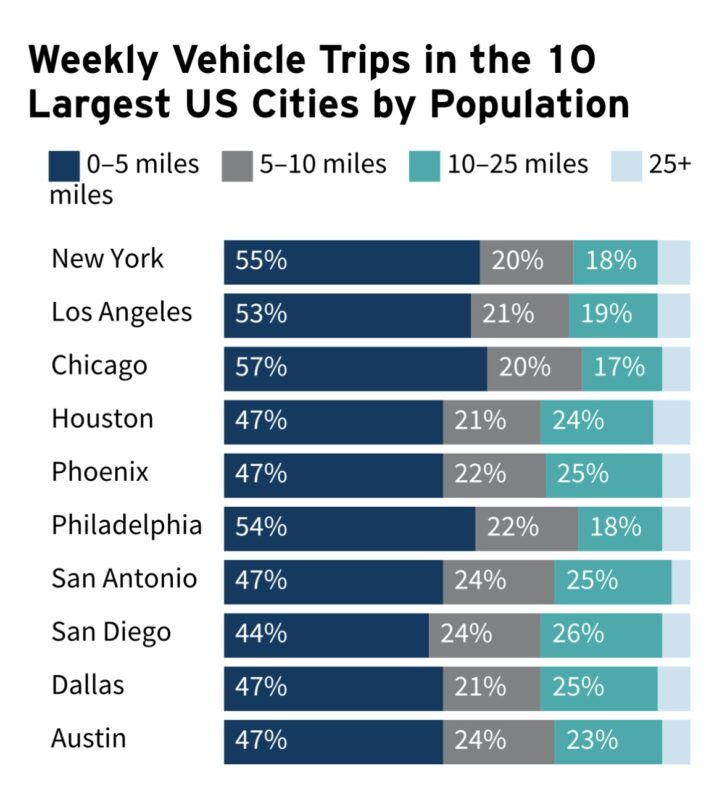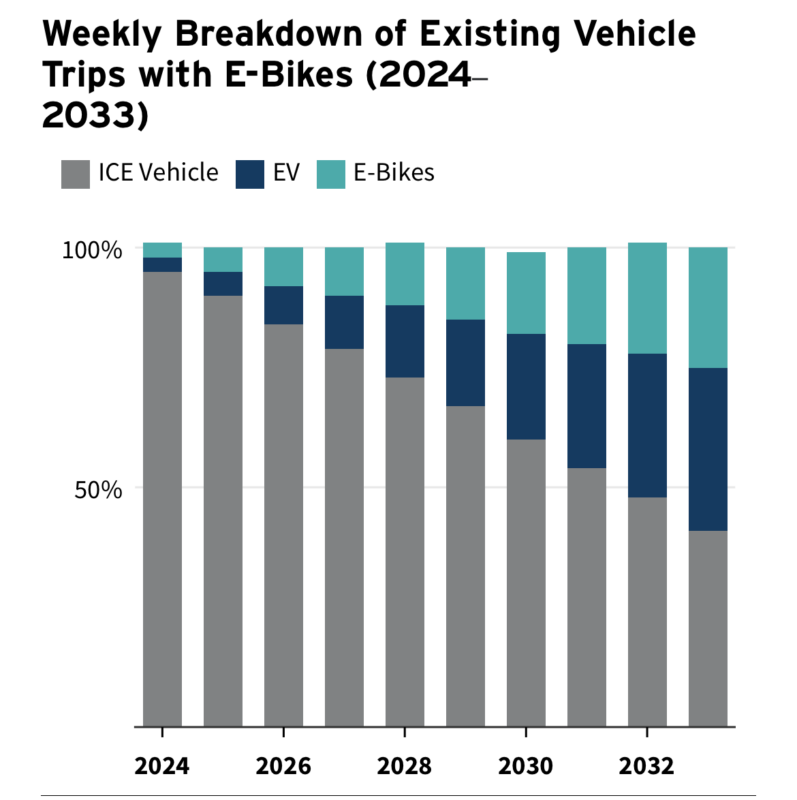Sign up for daily news updates from CleanTechnica on email. Or follow us on Google News!
RMI’s new e-bike calculator helps city policymakers and advocates quantify the environmental and economic benefits of replacing short-distance vehicle trips with e-bike trips
To avoid the worst effects of climate change, it’s widely understood that the United States will need to electrify its highest-emitting sector: transportation. What’s less understood is that even under the most ambitious emissions-reduction scenarios, the United States must also reduce vehicle miles traveled (VMT) by 20% before the end of the decade to stay on course for a 1.5°C future. Both electrification and VMT reductions are needed, and policymakers have an opportunity to advance both strategies at once to deliver equitable, climate-aligned outcomes in their communities. The key to this joint effort? E-bikes.
Electrification efforts to date have largely focused on replacing internal combustion engine (ICE) vehicles with electric vehicles (EVs). This emphasis is unsurprising given the car-centric culture of the United States — research shows that the average American drives about twice the number of miles per year as someone living in Germany, France, or the United Kingdom. This reliance on personal vehicles is a symptom of a nation dominated by highways and urban sprawl, where few have access to affordable and reliable public transportation, and where cities have a dearth of sidewalks and bike lanes.
Cutting VMT by enhancing accessibility will require a variety of interventions, including enabling more compact development and prioritizing climate-aligned infrastructure investments in bike lanes, transit, sidewalks, and so on. These shifts will in turn create an enabling environment for residents to shift away from single-occupancy ICE vehicles to more efficient modes of transportation such as walking, biking, and public transit.
Targeting High-Volume, Short-Distance Trips with E-Bikes
In 2021, the Bureau of Transportation Statistics found that over half of all trips in the United States were three miles or less and 60% of all vehicle trips were less than six miles. Given that short trips dominate transportation patterns in the United States, policymakers can target short vehicle trips with combined mode-shifting and electrification strategies centered on e-bikes. This approach will provide communities with a powerful way to achieve compounded benefits for accelerated transportation decarbonization.
In recent years, a growing number of cities have begun to recognize the environmental, economic, and social benefits of e-bikes. As e-bike sales continue to outpace those of passenger EVs, policymakers and others are beginning to seriously contemplate ways in which they can make e-bikes affordable and accessible to as many people as possible.
Programs such as Denver’s wildly popular e-bike incentive program are showing that policy can be a powerful lever to accelerate e-bike adoption. The Denver program’s vouchers are routinely claimed within minutes, and in 2022 alone, it put more than 4,700 e-bikes on the streets. The purchasers of these e-bikes rode an average of 26 miles per week, according to Denver’s survey of program participants.
Data-Driven Decision-Making for E-Bike Policies
The success of programs like Denver’s provides compelling evidence that e-bike rebate programs are effective. But policymakers still lack good data on the impacts of e-bikes, and many decision makers are looking for further proof points. That’s why RMI created the E-Bike Environment and Economics Impact Assessment Calculator for Cities to give policymakers, advocates, and other stakeholders the data they need to make data-driven decisions.
The calculator analyzes the environmental and economic impacts that e-bikes could have if they replaced a significant percentage of short motor vehicle trips (under five miles). It has two impact assessment scenarios that policymakers, city staffers, or other stakeholders can use:
- Assessing the citywide impact of replacing a percentage of short vehicle trips with e-bike trips, either over a period of 10 years or through an immediate shift; and
- Assessing the impact specifically derived from a city e-bike incentive program. Users can input their own variables, such as the total budget, timeline, number of commuting versus cargo bikes, and the portion of incentives for income-qualified participants, to see the potential impacts of a proposed program. Both scenarios produce insights into the resulting reductions in greenhouse gas emissions; air pollutants such as nitrogen oxides (NOx), fine particulate matter (PM2.5), and carbon monoxide; and vehicle miles traveled. Users can also see how much money e-bikes can save consumers, thanks to their low fuel and maintenance costs.
The first scenario is of particular use to policymakers and staffers who may be interested in setting a community-wide mode-shifting and/or e-bike target and understanding how that outcome would contribute to their community’s climate action plan and equity goals. The second scenario is of particular use to policymakers, staffers, and stakeholders who are interested in developing an e-bike incentive program for their community and understanding its benefits, or to communities with incentive programs that would like to assess their benefits.
Potential E-Bike Benefits in the Nation’s 10 Most Populous Cities
To demonstrate the capabilities of the calculator, RMI analyzed the potential e-bike benefits in the country’s 10 most populous cities. In those 10 cities, more than 50% of weekly vehicle trips are under five miles.
Reducing the number of these vehicle trips under five miles by 25% would produce a wealth of environmental, economic, and social benefits, as detailed in the charts below. Even as EV adoption grows over the next decade, shifting a portion of these trips to e-bikes now would result in immediate emissions reductions.
E-Bikes’ Environmental Benefits
Shifting short vehicle trips to other modes of accessible, convenient transportation can help local and national governments reduce VMT, contributing to broader transportation and climate goals. For example, shifting 25% of short vehicle trips from cars to e-bikes would cut overall VMT by 3% on average across the 10 cities. The table above shows the weekly and monthly vehicle miles traveled that would be reduced in each city if a quarter of short vehicle trips were replaced with e-bikes in 2024, totaling more than 461 million miles a month. Because the average American drives approximately 1,200 miles a month, cutting these vehicle trips in the 10 largest cities would be equivalent to removing over 388,000 vehicles from the road.
Avoided GHG Emissions and Gallons of Gas from Cutting 25% of Vehicle Trips Under Five Miles
VMT reduction leads to avoided gasoline and oil consumption — and thus a significant shift in greenhouse gas (GHG) emissions. Strikingly, if the top 10 most populous cities shifted a quarter of their short vehicle trips to e-bikes, they would save over 1.8 million metric tons of CO2 equivalent (CO2e) in one year — equivalent to avoiding the use of 208.5 million gallons of gasoline or 4.2 million barrels of oil. To put that into context, the emissions reductions would be equivalent to avoiding the use of four natural gas plants over the course of a year or running 514 wind turbines for a year.
For some individuals, shifting a quarter of their short vehicle trips to an e-bike may be an overly daunting task due to an unsafe bicycle commute, childcare responsibilities, or extreme temperatures. Nevertheless, encouraging residents to identify a portion of trips that can be shifted to an e-bike can yield significant impacts. If residents in the 10 most populated cities shifted one in eight short car trips to an e-bike, they would cut over 920,000 metric tons of CO2e, the same emissions reduction as avoiding the use of 2.3 natural gas plants over the course of a year. This shift would avoid the use of over 104 million gallons of gas or over 2 million barrels of oil.
Even on the weekly level, there are worthy impacts in terms of emissions reductions, improved local air quality, reduced gas consumption, and reduced costs for individuals from using a cheaper mode of transportation. Across the 10 cities, over 35,000 metric tons of CO2e could be avoided weekly, which is equivalent to avoiding the use of almost 4 million gallons of gasoline or almost 84,000 barrels of oil. These reductions are also equivalent to the emissions savings of bringing 9.9 new wind turbines online. These small, incremental changes add up.
E-Bikes’ Economic Benefits
Shifting short vehicle trips to e-bikes would also help residents save money. If a quarter of vehicle trips in the 10 most populous cities were switched to e-bikes now, users would save a combined $91 million every month, thanks to cutting their spending on fuel and vehicle maintenance by 19%. E-bike maintenance is often relatively inexpensive: many mechanical problems can be addressed by the user themselves without requiring a shop visit, and parts for the physical systems are relatively inexpensive when compared with a vehicle.
To maximize these savings, cities must build out networks of safe, connected bicycle infrastructure including separated bike lanes and secure parking areas. Networks of safe bicycle lanes that encourage ridership among vulnerable populations, including children, may make households more willing to forgo a second or third car, leading to greater savings from reduced car payments, insurance costs, and other expenses such as registration, parking, and emissions testing.
E-Bikes’ Social Benefits
While RMI’s calculator does not measure e-bikes’ effects on health or economic mobility, it’s logical to assume that widespread adoption could improve both.
As the American Lung Association notes, over 4 in 10 Americans — more than 135 million people — live in communities impacted by unhealthy levels of air pollution today, which translates to increased rates of asthma attacks, heart attacks, strokes, lung cancer, and premature death. Poor health outcomes are not shared evenly, with many communities of color and lower-income communities at greater risk due to increased exposure to transportation pollution.
Switching a quarter of short vehicle trips to e-bikes in the 10 most populated cities would cut fine particulate pollution (PM2.5) by 25%, compared with continuing to drive these trips. PM2.5 comes from the brake pads and tires of vehicles, as well as the combustion of fuels, and it has significant health impacts, such as increasing rates of cardiac, vascular, neurological, and pulmonary disease and some types of cancer. Gas-powered vehicles also produce nitrogen oxides (NOx) from the combustion of their fuels, which can harm the respiratory system and increase the risk of asthma or chronic lung diseases. Reducing the use of vehicles in city environments, where people are likely driving fewer than five miles, would help alleviate some of the health problems caused by air pollution from vehicles.
Furthermore, e-bikes can provide affordable, economic mobility, enhancing city equity goals, such as improving access to opportunities in transit deserts. A pilot program run by the National Renewable Energy Laboratory with the Colorado Energy Office, which distributed e-bikes to low-income essential workers in diverse locations around Colorado, showed that the e-bikes served unmet transportation needs, such as accessing employment. In some areas of Colorado, the bikes were shown to be competitive with cars in terms of speed and travel time, with much lower maintenance and energy costs.
E-Bikes’ Role as EV Adoption Increases
Even under aggressive EV adoption scenarios, e-bikes will have a place in reducing emissions long-term.
The charts below demonstrate how even a gradual adoption of e-bikes can help cut the usage of gas vehicles over the next 10 years, even in a scenario where EVs are adopted at the rate required to stick to the 1.5°C Paris Climate Agreement goal. Reaching a goal of having 25% of short vehicle trips be replaced with e-bikes in 10 years would cut ICE trips from 55% of all short vehicle trips down to 41%, saving emissions, money, and gas while reducing air pollution and promoting public health.
Even in 10 years, when electric vehicles make up over a third of all cars on the road, replacing a quarter of short trips annually would avoid over 1.1 million metric tons of CO2e, the same amount of GHG emissions that 2.8 natural gas plants produce in a year.
Urgent Action Is Needed Now — Not Later
Enabling and incentivizing e-bike adoption now yields massively different results compared with a slow, gradual adoption over 10 years. An additional 78 million metric tons of CO2e could be avoided if residents in the 10 most populous US cities immediately switched 25% of their short trips to e-bikes and that shift remained stable over 10 years, as compared with a gradual shift of short trips to e-bikes to meet a 25% target in 10 years. This difference across the two adoption hypotheticals is equivalent to avoiding the emissions produced by 19.7 natural gas plants over 10 years — demonstrating the urgency to strive for sweeping changes as soon as possible.
While the calculator does not yet analyze how safe and connected bicycling infrastructure can promote increased ridership, it is important to acknowledge that the public must feel safe riding a bicycle to effectively shift trips from vehicles to e-bikes and realize their benefits. States, cities, counties, and metropolitan planning organizations are responsible for significant portions of the nation’s transportation planning and can direct funding to protected bike lanes and related infrastructure that will encourage ridership. Research from around the world shows that proactively strengthening infrastructure increases ridership — for instance, pop-up lanes popularized during the pandemic rapidly boosting bicycle ridership. The importance of infrastructure in boosting ridership is most evident in cities such as Portland, Oregon, Boulder, Colorado, and Minneapolis, Minnesota which consistently rank highly for their bicycle ridership, despite cold or rainy climates.
Cities must act now by investing in safe and connected bicycle infrastructure to improve access and drive adoption as rapidly as possible. Implementing these changes to our streetscapes in cities and suburbs alike will reduce emissions and provide economic savings, while creating more livable, thriving communities for all.
This calculator only demonstrates the potential impact to be had. In order to realize the climate benefits of e-bikes, we cannot sit passively and wait for individuals to change their patterns of behavior. Policymakers will need to enable and incentivize the change they want to see. An all-hands-on-deck approach will be needed, including shifting funds toward connected, protected bike lanes and safe places to store bikes, incentive or rebate programs to help reduce the cost burden for city residents, and campaigns that support consumer awareness and adoption of e-bikes.
Access RMI’s E-Bike Environment and Economics Impact Assessment Calculator for Cities here. This is the first version of the calculator — future versions will expand utility and information. Please reach out to our team with any questions about the underlying calculations. Furthermore, please let us know if your city is not included in the tool so we can add it in our next update.
REPORT | 2023
E-Bike Environment and Economics Impact Assessment Calculator
DOWNLOAD THE ANALYSIS
By Bryn Grunwald, Heather House, Jacob Korn © 2023 Rocky Mountain Institute. Published with permission. Originally posted on RMI.
Have a tip for CleanTechnica? Want to advertise? Want to suggest a guest for our CleanTech Talk podcast? Contact us here.
EV Obsession Daily!
I don’t like paywalls. You don’t like paywalls. Who likes paywalls? Here at CleanTechnica, we implemented a limited paywall for a while, but it always felt wrong — and it was always tough to decide what we should put behind there. In theory, your most exclusive and best content goes behind a paywall. But then fewer people read it!! So, we’ve decided to completely nix paywalls here at CleanTechnica. But…
Thank you!
Tesla Sales in 2023, 2024, and 2030
CleanTechnica uses affiliate links. See our policy here.









